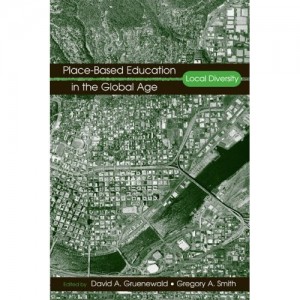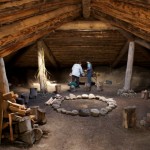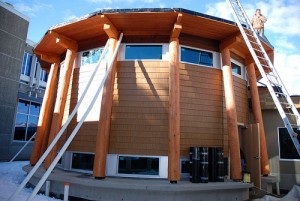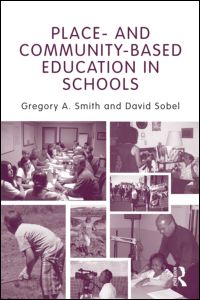This webpage is a part of the World Council of Churches website and in keeping with their mandate to reach the world and draw Christians together, they are intimately involved with the lives of all people from all walks of life. This article written by Raymundo Rovillos, looks at the issues that prompted change in the education system of the indigenous people. He looks what the attempts of globalization and colonization brought about in the name of consolidated global power. He reveals evidence of educational inequalities which led to the marginalization of the indigenous people. The United Nations intervention is then highlight as the initiative that sparked hope in the people and encouraged them to regain their cultural origins and rights.
Aboriginal Health
The National Aboriginal Health Organization (NAHO) as the name suggest, focuses on the promotion of health and well-being of indigenous people. It is a non-profit organization geared towards achieving holistic development of indigenous people through individual and group/community support. The aim of the site is for knowledge sharing, thus empowering the people. Complete with links, publication, video, up to date news and other resources users will have a rich and rewarding experience once they have interacted with the cite offerings. Navigation is easy and the information provided offers guidance and help all disadvantaged groups
Indigenous Schooling
The Department of Education, Employment and Workplace Relations (DEEWR) is a vision of the Australian Government. The website echoes the mission of the government to reduce the disadvantages faced by indigenous peoples in terms of schooling and education. By navigating the website, viewers are able to find details information on the many course offerings available, become aware of the different school help programs as well as see the many activities and resources available. Links to forums, news, articles and many other related topics are available.
http://www.deewr.gov.au/Indigenous/Schooling/Pages/default.aspx

Through literature survey for my research project I found this book; Place-based Education in the Global Age: Local Diversity (by Smith and Gruenwald, 2008) as an important and timely collection of work that explains how Indigenous people should reintegrate their own knowledge systems into the school curriculum as a basis for connecting what students learn in school with life out of school. This process has sought to restore a traditional sense of place while at the same time broadening and deepening the educational experience for all students.
The book frames place-based pedagogy not just as an alternative teaching methodology or novel approach to environmental education but as part of a broader social movement which aims toward reclaiming the significance of the local in the global age. Meanwhile, it links development of ecological awareness and stewardship to concerns about equity and cultural diversity. Several examples of place-based education in action that discuss the connections between learners and their wider communities are also demonstrated in this book.
While researching for my ETEC 521 paper, I came across a tremendously interesting read. And it would so happen, this read fits in beautifully to our current discussion theme. This research paper proposes that teaching is a cultural transmission and learning is a cultural acquisition.
Teachers’ Views on Aboriginal Students Learning Western and Aboriginal Studies
” 1. Teachers generally viewed Western science as course content or as a way of exploring nature, not as a foreign culture as experienced by many of their students.
2. Aboriginal knowledge was respected by science teachers, but only a token amount was added onto, but not integrated with, school science.
3. Teachers thought that the act of learning science was unrelated to their students’ Aboriginal worldviews.
4. Students’ disinterest in pursuing science careers was either unexplainable by the interviewees or was blamed on student deficits. Few teachers blamed their curriculum and teaching. ”
“They need a teacher who is a “culture broker” (Stairs, 1995). A culture-broker science teacher will help students move back and forth between their indigenous culture and the culture of Western science, and will help students deal with cultural conflicts that arise.” (Aikenhead & Huntley)
Although a bit dated, the article had fabulous resources. I do wonder though if this good information was available 15 + years ago -why are we still doing such a dreadful job of enabling our aboriginal students (all of our students) reach their potential?
Aikenhead, G., & Huntley, B. (n.d.). Teachers’ views on aboriginal students learning western and aboriginal studies. Retrieved from http://www.usask.ca/education/people/aikenhead/cjne.pdf
Stairs, A. (1995). Learning processes and teaching roles in Native education: Cultural base and cultural brokerage. In M. Battiste & J. Barman (Eds.), First Nations education in Canada: The circle unfolds. Vancouver, Canada: University of British Columbia Press, pp. 139-153.
To support an inquiry project that our district is about to begin, I investigated possible meeting sites for the education stakeholders that will come together in learning and understanding. I was hoping to locate sites other than school district property where all participants could come together.
Three (at least) such sites are within access of our group. To date I have visited two of the sites.
The first is the Mir Centre for Peace. The Doukobors began migrating to the area in 1908. At that time the land was home to First Nations peoples and European settlers. The relationship between the Doukobors and local First Nations were not always peaceful. Land beside Selkirk College was given to the college and late in the 20th Century the idea of the Mir (peace, community, and world) Centre was born. The site was to see the restoration of one of the few remaining Doukobor buildings and space set aside on the land for First Nations Ceremony and Structure.
 The second site that I visited was the Sinixt pit house located in the Slocan valley. Radio carbon dating suggests that the pit house was occupied as early as 3000 years ago and as recently as 200 years ago. In 1987 artifacts, skeletal remains and pit house depressions were discovered when the Ministry of Highways began road construction in the Slocan Valley. Through great restoration efforts the pit house is now an awesome place to visit and in which to learn and reflect. Click on the image of Marylin James to see a short video on the pit house restoration project.
The second site that I visited was the Sinixt pit house located in the Slocan valley. Radio carbon dating suggests that the pit house was occupied as early as 3000 years ago and as recently as 200 years ago. In 1987 artifacts, skeletal remains and pit house depressions were discovered when the Ministry of Highways began road construction in the Slocan Valley. Through great restoration efforts the pit house is now an awesome place to visit and in which to learn and reflect. Click on the image of Marylin James to see a short video on the pit house restoration project.
The third and final site is the Selkirk College Aboriginal Gathering Place. Next on my list for a visit.
Wilkinson, M. (2006, Fall). Mir centre for peace at selkirk college:understanding and building cultures of peace. Retrieved from http://selkirk.ca/media/innovation/mircentreforpeace/history/MIR-History—-Myler’s-09-02-25.pdf
I found this article (by Paul Cappon, 2008) as an interesting one because although the Canadian Council on Learning (CCL) has developed the world’s first composite learning index to track Canada’s progress in lifelong learning but data gaps hamper measurement of success among Aboriginal learners. This study explains how CCL and its Aboriginal Learning Knowledge Centre, in partnership with Aboriginal people and organizations, have taken important steps to rectify that. First Nations, Inuit and Métis holistic lifelong learning models illustrate the place of learning in the Aboriginal world view, its sources, how people learn and the connection between learning and community well being. Most important, they help identify what learning success means for Aboriginal communities and provide a framework of indicators to track progress. Those learning models can re-frame what has too often been regarded as an intractable policy challenge and transform it into an exciting field of opportunity with multiple benefits for the success of Aboriginal learners, for the regeneration and well-being of First Nations, Inuit and Métis communities, for regional and national economies and for the health and social cohesion of Aboriginal and Canadian society.
http://www.ccl-cca.ca/NR/rdonlyres/0D0A5FA7-1191-43D9-A46D-F13D7C9BECAB/0/Cappon_PolicyOptions.pdf
Before Technology – The Story
We often hear that technology should never be used for technology’s sake.
In my last post I asked “Who are we?”. Wondering who the children of aboriginal ancestry (including my two children) are that attend our schools. I began investigating. I began with the information to be found on the Statistics Canada Website but was unsatisfied with the findings. Only information for Trail, BC was found yet we are a district that comprises six municipalities and many other small communities.
(2011). Achievement contract. Retrieved from School District No. 20 Kooteny-Columbia website: http://www.sd20.bc.ca/tl_files/Achievement Contract/2011-12 Achievement Contract COMPLETE.pdf
School district no. 20 kootenay-columbia board of education. (2011). Retrieved from http://www.sd20.bc.ca/board.html
Place and Community-based Education in Schools (2010) is a book by Gregory A. Smith and David Sobel. Their discussion about an approach to teaching and learning that starts with the local, addresses two critical gaps in the experience of many children now growing up in North America: contact with the natural world and contact with community. The book offers a way to extend young people’s attention beyond the classroom to the world as it actually is, and to engage them in the process of devising solutions to the social and environmental problems they will confront as adults. This approach can increase students’ engagement with learning and enhance their academic achievement.
The book also explains the purpose and nature of place and community-based education and provides multiple examples of its practice. Through the book, the detailed descriptions of learning experiences set both within and beyond the classroom help me and other readers understand the process of advocating for or incorporating local content and experiences into schools.
Module 4 – INUIT TAPIRIIT KANATAMI (ITK)
Inuit Tapiriit Kanatami (ITK) is the national Inuit organization in Canada, representing four Inuit regions – Nunatsiavut (Labrador), Nunavik (northern Quebec), Nunavut, and the Inuvialuit Settlement Region in the Northwest Territories. Founded in 1971 ITK represents and promotes the interests of Inuit on a wide variety of educational, environmental, social, cultural, and political, issues and challenges facing Inuit on the national level.
ITK web page has a publications section that contains a wide range of important resources related to Inuit education. As an example, through studying for my research paper I found a very interesting article: “The Literature on Inuit-Centred Curriculum and Teaching Approaches” that explains three dominant themes in the literature concerning Inuit-centred curriculum and teaching approaches as: 1) importance of understanding the broad social and economic relations which shape curriculum; 2) analysis and recommendations regarding pedagogy for Inuit-centred teaching and curriculum; and 3) policy and governance issues affecting Inuit-centred curriculum and teaching. (http://www.itk.ca/publication/documentation-national-strategy-inuit-education). In terms of practice and policy, the article also reveals many experiments and innovations for Inuit curriculum and teaching.


